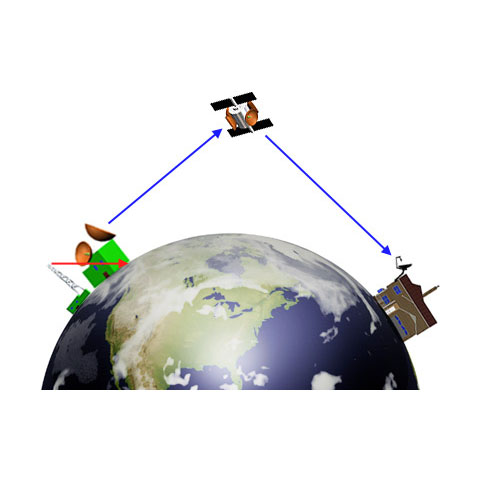How Does Satellite TV Work?
We help people pick out their best options for TV and other internet services.

At the Connected Home, we help people pick out their best options for TV and other internet services. for many people, the answer is Satellite TV. Which frequently raises the question of just what is Satellite TV? And how does it work?
Conceptually, satellite TV is a lot like broadcast TV. It’s a wireless system for delivering television programming directly to a viewer’s house. Both broadcast television and satellite stations transmit programming via a radio signal.
Broadcast stations use a powerful antenna to transmit radio waves to the surrounding area. Viewers can pick up the signal with a much smaller antenna. The main limitation of broadcast TV is range. The radio signals used to broadcast television shoot out from the broadcast antenna in a straight line. In order to receive these signals, you have to be in the direct line of sight of the antenna. Small obstacles like trees or small buildings aren’t a problem; but a big obstacle, such as the Earth, will reflect these radio waves. Read more here
There are Five Main Components to a Satellite to Home TV transmission…
- Programming sources are simply the channels that provide programming for broadcast. The provider doesn’t create original programming itself; it pays other companies (HBO, for example, or ESPN) for the right to broadcast their content via satellite. In this way, the provider is kind of like a broker between you and the actual programming sources. (Cable TV companies work on the same principle.)
- The broadcast center is the central hub of the system. At the broadcast center, the TV provider receives signals from various programming sources and beams a broadcast signal to satellites in geosynchronous orbit.
- The satellites receive the signals from the broadcast station and rebroadcast them to Earth.
- The viewer’s dish picks up the signal from the satellite (or multiple satellites in the same part of the sky) and passes it on to the receiver in the viewer’s house.
- The receiver processes the signal and passes it on to a standard TV.
Source: http://electronics.howstuffworks.com/satellite-tv2.htm
So just how high are these Satellites?
Satellite TV works by broadcasting video and audio signals from geostationary satellites to satellite dishes on the Earth’s surface. These geostationary satellites orbit the earth in a region of space known as the Clarke Belt, which is approximately 22,300 miles above the equator.
Each of these satellites carries a number of transponders. These transponders each carry a signal back to the Earth.
These signals are typically on C Band, Ku Band, or Ka Band. The band of a signal describes, in broad terms, the frequency of the signal. After travelling over twenty thousand miles, these signals are received by a satellite dish.
This dish can be as small as 18″ across, or it can be 9′ or larger across. The purpose of the dish is to act as a collector and a reflector. The dish collects the signal and reflects it towards the feedhorn.
The feedhorn receives the reflected signal and sends it to the LNB. The LNB amplifies the signal and converts it to a frequency more suitable for transmission over a cable. In satellite terminology, that cable is known as the IFL. The LNB transmits the signal over the IFL to the satellite receiver. The satellite receiver then sends the signal to your television set.
Read more here: http://www.tech-faq.com/satellite-tv.html
Back in the late 1950’s and 60’s satellites were science fiction come to life.
Today, the globe is surrounded by thousands of them, doing everyday service for millions if not billions of humans around the world. While the technology has grown to be an everyday reality, the skill to properly connect your home to the world via satellite tv, or satellite internet still requires a sophisticated level of skill and expertise.
Let The Connected Home Help
Let us help you find the right internet plan for your needs. Call now to start comparing providers, prices and speeds in your local area.
Call 612-424-8483
